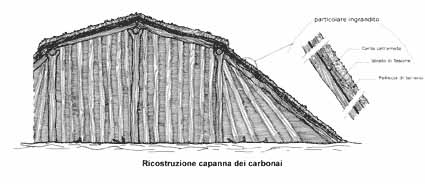The Charcoal Burner
The preparation of the charcoal mound requires much time and attention; each aspect is scrupulously monitored to obtain high quality charcoal.
The preparation of the charcoal mound requires much time and attention; each aspect is scrupulously monitored to obtain high quality charcoal.
The forest's resources and lost crafts: charcoal making.
Up until the 1950's charcoal making, together with other agricultural and forestry work, represented an important source of income for the resident population in many
Tuscan mountain areas.
Charcoal making was a country method for turning wood into charcoal; a product with double the calorific output of wood. The mound was a conical beehive shape made from chopped branchs and small wood and set in a cleared area of ground known as the aia carbonile or charcoal floor.
The mound was constructed in a forest clearing on ground as level as possible and protected from winds. Three poles were mounted in the centre at a distance of 30 –40 cm from each other to form an equilateral triangle. Their height was that of the finished mound. Offcuts of wood resulting from wood cutting in the surrounding deciduous forest were stacked vertically against these poles.These pieces of wood (mostly holm oak, arbutus, turkey oak and manna-ash) were cut to equal lengths and placed in 2 or 3 layers to form a dome whose height was about 3/4 the diameter of its base. The next phase was to cover these with damp leafy branches followed by a layer of wet earth. Holes were made in the base to light the fire and then closed once the fire had taken hold leavig only small air vents open.
The charcoal burner was constantly on hand to monitor the process of carbonization which usually lasted 8-10 days, after which the fire was spent by closing all the vents and letting the mass cool down. The mound was then taken apart to gather the
resulting excellent quality charcoal.
 A reconstruction of the charcoal burner's hut built as a shelter for his many nights' vigil tending the charcoal mound.
A reconstruction of the charcoal burner's hut built as a shelter for his many nights' vigil tending the charcoal mound.



